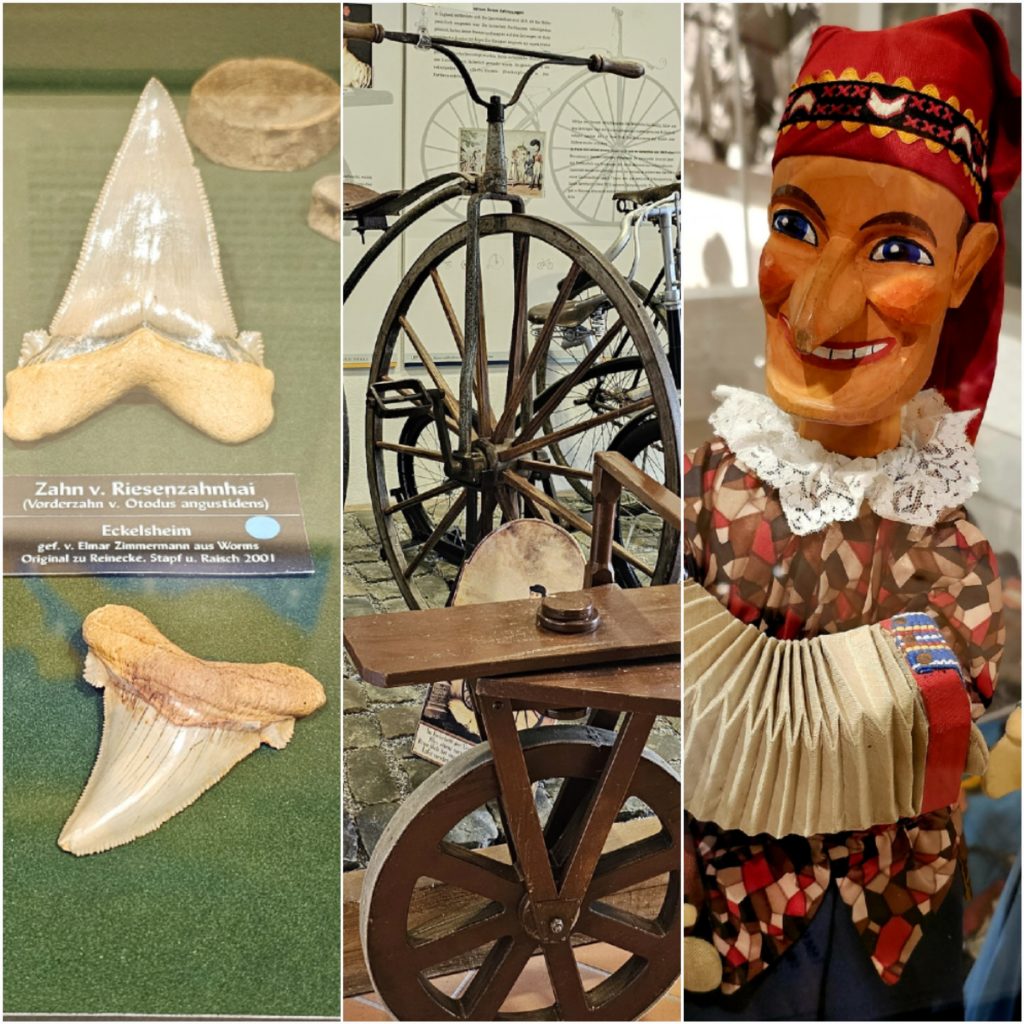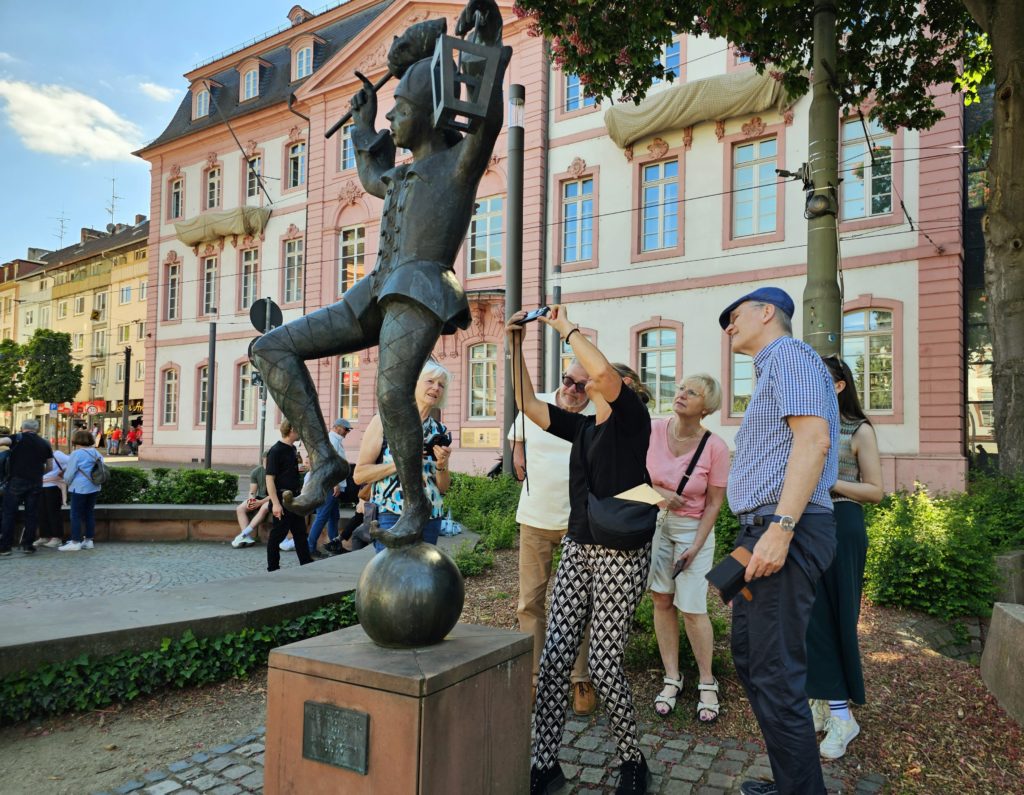An offer we cannot refuse
We start our journey to Dalsheim in the present time. When we get out of the car, however, we have landed in the middle of the year 1860. Margret, the wife of the Dalsheim night watchman, comes towards us excitedly with her lantern and basket. Again she can't find her husband, it's always the same! Now, once again, she has no choice but to take care of order and the night's rest of the inhabitants. Wouldn't we like to accompany her for an hour, then she wouldn't be so alone? How can we say no to that?
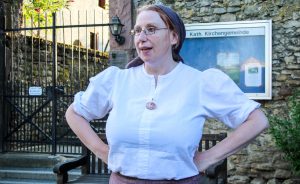
We start to move and Margret tells a swing from her life. She was born in 1816. "Just like Rheinhessen itself!" she mentions proudly. Already her father and grandfather were night watchmen. A responsible job, after all, as the mayor's vicarious agent, he had to check every night that all doors were locked and all fires extinguished. With 134 houses in the village, this is a big task. In addition, no riffraff was allowed to roam around in the village.
On the wall, lying in wait
We head for the historic Fleckenmauer from the 15th century, which is quite historic even in 1860. The stone wall is the only completely preserved medieval town fortification in Rheinhessen. We climb up the tower and have a beautiful view all the way to Worms, Mannheim and Ludwigshafen. The Odenwald and the Rhine line are also clearly visible.
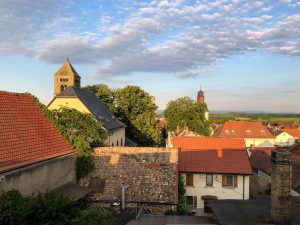
We guess why the spotted wall has this unusual name. Because of the many different stones, perhaps? Margret knows better. The name Fleckenmauer comes from the designation of Dalsheim as a "Flecken". Not a town, not a village, but a Marktflecken - an old expression for market town.
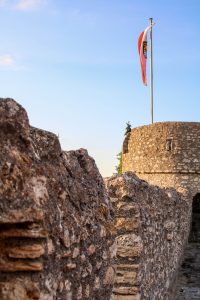
Tip: Even without a night watchman's tour, you can climb the Fleckenmauer in stable weather conditions. If the door at the Obertor Tower is locked, you can ask for the key next door at the Strubel Winery.
The own three walls
In the further course of the tour we follow the stain wall. Margret shows that many houses were built right up against the city wall. Thus, only three walls were necessary for the construction of houses at that time. Where wall houses were demolished, we still see here and there a seemingly random window or passageway in the stain wall. Margret notes with a twinkle in her eye, "In Rheinhessen, not everything is as it seems!"

Time for change
We reach the witches' tower on the west side of the wall. Here Margret has to sing the hours. She has her grandfather's horn with her for this purpose. With a little song she announces the current time.
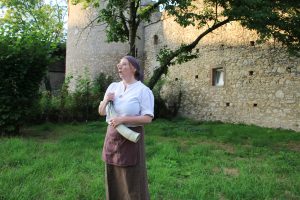
The horn has another important function, Margret reveals. If she discovers a fire on her rounds, she has to blow the horn. The sexton then rings the church bell. Then all the residents come running with buckets of water to put out the fire. According to Margret, there has also been such a newfangled "spray train" recently. The fire insurance in the village is also new.

In general, so much is new. She doesn't understand some of the changes. They build rails here without end. But Margret would never get on the train. At that speed, people would burst in rows!
The Sun King and the Fire
We walk to the center of Dalsheim. Margret shows us a house that had to be completely rebuilt in 1716. Why? Well, there was Liselotte of the Palatinate, who married the brother of the Sun King. Nevertheless, the resistance from the region against France did not decrease. And from there it was said, "What cannot be mine, let it burn!" Dalsheim was not spared from the Palatine War of Succession either, and so only 70 people in 17 families survived the devastating fires and looting in the village. A tragedy!

These French people are really something! Nothing but fluff in their heads! Margret asks us if we know the expression "fisimatenten". Yes? Then we would know for sure that the French soldiers always wanted to lure young women into their tents with "Visite ma tente!
Leave three churches in the village
We have already discovered the three church towers of Dalsheim on the spot wall. Now Margret shows us the houses of worship and explains why there are so many churches in such a small area. Actually, it is quite simple: a Catholic, a Reformed and a Lutheran church. Everything that is needed! Today, the latter two are united under the umbrella of the Protestant church and are visited alternately for church services.
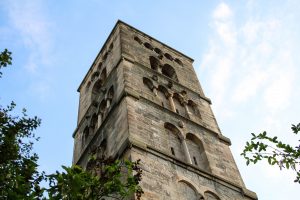
Just pile up?
In the Untertorturm lived until 1834 a Türmer, who left after an escalated dispute. Türmte, so to speak. People in the village rumored that he had gone to America with his family. Margret tells that many of her acquaintances also play with this thought. The Realerbteilung makes life difficult for most of them.

Margret herself also considers emigrating to America from time to time, but Le Havre - where the ships leave - is much too far away and she doesn't get on a train on principle. So she stays here and continues to make her rounds through Dalsheim. After all, that's not bad either.

We pass the old school. Margret tells us that the students only have two hours of lessons in the summer, then they help in the field. That is also our next destination. On the outskirts of Dalsheim we stand directly in front of the vines. From here we have a last beautiful view of the Fleckenmauer before we say goodbye to Margret after about an hour at the Obertorturm. By the way, she still has not found her husband ...
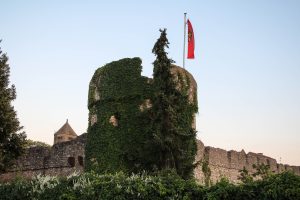
A journey through time
Margret's real name is Beate Hess and she is a passionate tour guide. "When night watchmen's wives tell ..." is the popular costume tour through the romantic alleys of Dalsheim, offered by the "Interessengemeinschaft Flörsheim-Dalsheimer Gästeführer" with a lot of heart, passion and a large portion of dialect.

We were allowed to accompany Beate Hess alias Margret in the summer. But the interactive night watchman tour actually takes place from November to March held on the first Saturday of each month at 7 pm - then, when it is already nice and dark. In addition to the open tours, you can also book a private tour for groups at any time.

Of course, there are also numerous opportunities to get to know Dalsheim and its Fleckenmauer during guided tours in the summer months. In addition to the open tours on Saturdays at 5 p.m. there are also numerous themed and special tours.
Tip: Are you real medieval fans? Every four years, Dalsheim hosts a large medieval festival in which all clubs actively participate. Due to a pandemic, the next festival has now been postponed to 9 - 11.9.2022.

